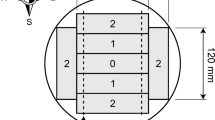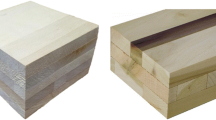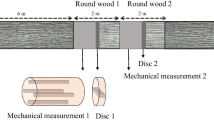Summary
The overall aim of this study and series of papers is to address the key variables for timber quality and to optimize the utilization of Norway spruce timber with respect to construction purposes. It is the end-user's degree of overall satisfaction that determines the quality of a product. Therefore, the performance of structural timber cannot solely be defined by mechanical properties. Geometric performance (warp) must be improved if timber is to continue as an important building material.
An experimental study of the spatial variation in warp and bending properties of fast-grown Norway spruce is introduced. In this paper, the growth characteristics are presented as a function of stand and location in the tree. The knot area ratio (KAR) was considerably higher in the core (0.31) compared with timber closer to bark (0.21). The top log studs had higher KAR (0.38) than the corresponding butt log studs (0.31). The average grain angle was 3.5% (≈ 2°) and appeared not to vary radially. The presence of compression wood was much more common in the top log timber (75%) than in the butt log (44%). However, no consistent radial variation in compression wood was found.
Similar content being viewed by others
References
Anon 1973: BS 4978: 1973, Timber grades for structural use. British Standards Institution
Anon 1986: ISO 8402-1986 Quality —Vocabulary
Balodis, V. 1972: Influence of grain angle on twist in seasoned boards. Wood Science, 5(1): 44–50
Barrett, J. D.; Kellogg, R. M. 1991: Bending strength and stiffness of second-growth Douglas-fir dimension lumber. Forest Prod. J. 41(10): 35–43
Beard, J. S.; Wagner, F. G.; Taylor, F. W.; Seale, R. D. 1993: The influence of growth characteristics on warp in two structural grades of southern pine lumber. Forest Prod. J. 43(6): 51–56
Bendtsen, B. A. 1978: Properties of wood from improved and intensively managed trees. Forest Prod. J. 28(10): 61–72
Bendtsen, B. A.; Senft, J. 1986: Mechanical and anatomical properties in individual growth rings of plantation-grown eastern cottonwood and loblolly pine. Wood and Fiber Sci. 18(1): 23–28
Blomqvist, H. 1987: Växtvridet timmer: Mätningsproblem och egenskaper hos sågad vara (Spiral-grained timber: Scaling problems and properties of the sawn wood, in Swedish). Swedish Univ. of Agricultural Sciences, Dept. of Forest Prod., Report No. 194, Uppsala, Sweden
Brazier, J. D. 1965: An assessment of the incidence and significance of spiral grain in young conifer trees. Forest Prod. J. 15: 308–312
Danborg, F. 1990: The effect of silvicultural practice on the amount and quality of juvenile wood in Norway spruce. Presented at IUFRO World Congress, Montreal, Canada
Danborg, F. 1991: Nåletræarternes tekniske egenskaper: Tørreegenskaper og visuel styrkesortering af hurtigt vokset rødgran og sitkagran (Mechanical properties of softwoods: Warp properties and strength grading of fast-grown Norway spruce and Sitka spruce, in Danish). Royal Veterinary and Agricultural Univ., Dept. of Forestry, Copenhagen, Denmark
Du Toit, A. J. 1963: A study on the influence of compression wood on the warping of Pinus radiata timber. S. African Forestry J. 44: 11–15
Hallock, H. 1965: Sawing to reduce warp of loblolly pine studs. USDA Forest service, Forest Prod. Lab., Research paper FPL-51, Madison, USA
Hallock, H.; Malcolm, F. B. 1972: Sawing to reduce warp in plantation red pine studs. USDA Forest service, Forest Prod. Lab., Research paper FPL-164, Madison, USA
Harvald, C. 1988: Nåletræarternes tekniske egenskaper (Mechanical properties of softwoods, in Danish). Royal Veterinary and Agricultural Univ., Dept. of Forestry, Copenhagen, Denmark
Harvald, C. 1989: Nåletræarternes tekniske egenskaper: Hugststyrkens indflydelse på konstruktinstræets bøjningsstyrke og E-modul i rødgran (Mechanical properties of softwoods: Influence of thinning on mechanical properties of Norway spruce, in Danish). Royal Veterinary and Agricultural Univ., Dept. of Forestry, Copenhagen, Denmark
Hillis, W. E. 1984: High temperature and chemical effects on wood stability —Part 1: General considerations. Wood Sci. and Tech. 18: 281–293
Hillis, W. E.; Rozsa, A. N. 1985: High temperature and chemical effects on wood stability —Part 3: The effect of heat on the rigidity and the stability of radiata pine. Wood Sci. and Tech. 19: 93–102
Høibø, O. A. 1991: The quality of wood of Norway spruce (Picea abies) planted with different spacing. Agricultural Univ. of Norway, Dept. of Forestry, Doctor Scientarium Theses 1991:13, Ås, Norway
Johansson, F.; Nyhlén, T.; Yngvesson, M. 1990: Kvaliteten hos virke från planterad och självsådd gran på god bonitet i södra sverige (Wood quality from planted and naturally regenerated spruce on good sites in southern Sweden, in Swedish). Swedish Univ. of Agricultural Sciences., Dept. of Forest Products, Report No. 220, Uppsala, Sweden
Johansson, G.; Kliger, I. R.; Perstorper, M. 1991: Quality requirements for structural timber used by the building industry. Proc. of the 1991 Int. Timber Eng. Conf., TRADA, Vol. 4, p. 421–428, London
Johansson, G.; Kliger, I. R.; Perstorper, M. 1993: Structural Sawn Timber Quality Requirements. Struct. Eng. Int. (IABSE), 3(2): 99–103
Johansson, G.; Kliger, I. R.; Perstorper, M. 1994: Quality of structural timber-product specification system required by end-users. Holz als Rohund Werkstoff 52(1): 42–48
Johansson, K. 1992: Effects of initial spacing on the stem and branch properties and graded quality of Picea abies (Norway spruce). Scan. J. For. Res., 7: 503–514
Johansson, K. 1993: Influence of initil spacing and tree class on the basic density of Picea abies (Norway spruce). Scan. J. For. Res. 8: 18–27
Kellogg, R. M. 1989: Second growth Douglas-fir: Its management and conversion for value. Forintek Canada Corp., Special Publication SP-32, Vancouver, Canada
Kininmonth, J. A. (Ed.) 1987: Proceedings of the conversion planning conference. Forestry Research Institute, FRI Bulletin No. 128, Rotorua, New Zealand
Kloot, N. H.; Page, M. W. 1959: A study of distortion in Radiata pine scantlings. CSIRO, Div. of For. Prod., Technological Paper No. 7, Melbourne, Australia
Kretschmann, D.; Bendtsen, B. A. 1992: Ultimate tensile stress and modulus of elasticity of fast-grown plantation loblolly pine lumber. Wood and Fiber Sci., 24(2): 189–203
Kyrkjeeide, P. A. 1990: A wood quality study of suppressed, intermediate and dominant trees of planation grown Norway spruce (picea abies), Dissertation for skogbrukskandidat degree. Forest Products Laboratory, USDA Forest Service, Madison, USA
Kyrkjeeide, P. A.; Thörnqvist, T. 1994: Tryckved —en litteraturstudie med reflexioner (Compression wood —a literature review with comments, in Swedish). Swedish Univ. of Agricultural Sciences, Dept. of Forest-Industry-Market-Studies, Report No. 35, Uppsala, Sweden
Mackay, J. F. G.; Rumball, B. L. 1971: Drying of distortion prone juvenile core radiata pine for house studs. Aust. Timber J. 37(6): 43–57
Maeglin, R. R.; Boone, R. S. 1983: An evaluation of Saw-Dry-Rip (SDR) for the manufacture of studs from small ponderosa pine logs. USDA Forest Service, Forest Prod. Lab., Research Paper FPL-435, Madison, Madison, USA
Maeglin, R. R.; Boone, R. S. 1986: Increased stud grade yield of plantation southern pine by Saw-Dry-Rip. USDA Forest Service, Forest Prod. Lab., Research Paper FPL/479, Madison, USA
Malcolm, F. B. 1968: Warp in studs from small-diameter loblolly pine. Southern Lumberman 216:2687
Mishiro, A.; Booker, R. E. 1988: Warping in new crop Radiata pine 100×50 mm boards. Bulletin of the Tokyo University Forests 80: 37–68
Nilsson, M. 1993: Theory and measurements of growth stresses-a literature review. Lund Institute of Technology, Div. of Struct. Eng., Report No. TVBK-7041, Lund, Sweden
Noskowiak, A. F. 1963: Spiral grain in trees. A review. Forest Prod. J. 13(7): 266–275
Nylinder, P. 1958: Synpunkter på produktionens kvalitet (A study on quality production, in Swedish). St. Skogsforskn. inst., Uppsats 64, Stockholm, Sweden
Panshin, A. J.; DeZeuw, C. 1980: Textbook of wood technology 4th Ed. Vol. I. McGraw-Hill, New York, USA
Pearson, R. G.; Gilmore, R. C. 1980: Effects of fast growth rate on the mechanical properties of Loblolly pine. Forest Prod. J. 30(5): 60–66
Pellikane, P. J.; Hilson, B. O.; Smith, I. 1986: A critical appraisal of the prospects for the United Kingdom glulam industry. J. Inst. of Wood Science 10(5): 202–209
Senft, J. F.; Bendtsen, B. A.; Galligan, W. L. 1985: Weak wood: fast grown trees make problem lumber. J. of Forestry 83 (8): 476–484
Shelly, J. R.; Arganbright, D. G.; Birnbach, M. 1979: Severe warp development in young-growth ponderosa pine studs. Wood and Fiber 11 (1): 50–56
Shivnaraine, C. S. 1989: Within stem variation in bending strength and stiffness of lumber from plantation grown white spruce. Univ. of New Brunswick, Wood Science and Tech. Centre, MSC thesis, Fredricton, Canada
Simpson, W. T.; Danielson, J. D.; Boone, R. S. 1988: Press-drying plantation-grown loblolly pine 2 and 4's to reduce warp. Forest Prod. J. 38(11): 41–48
Zhou, H. 1989: The influence of drying, knots and slope of grain on bending properties of white spruce. Univ. of New Brunswick, Wood Science and Tech. Centre, MSC thesis, Fredricton, Canada
Author information
Authors and Affiliations
Additional information
The authors gratefully acknowledge the support from EEC Forest programme, Contract No. MA2B-0024 and from Södra Timber AG from NUTEK project No. 9100554
Rights and permissions
About this article
Cite this article
Perstorper, M., Pellicane, P.J., Kliger, I.R. et al. Quality of timber products from Norway spruce. Wood Sci.Technol. 29, 157–170 (1995). https://doi.org/10.1007/BF00204581
Received:
Issue Date:
DOI: https://doi.org/10.1007/BF00204581




